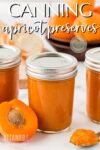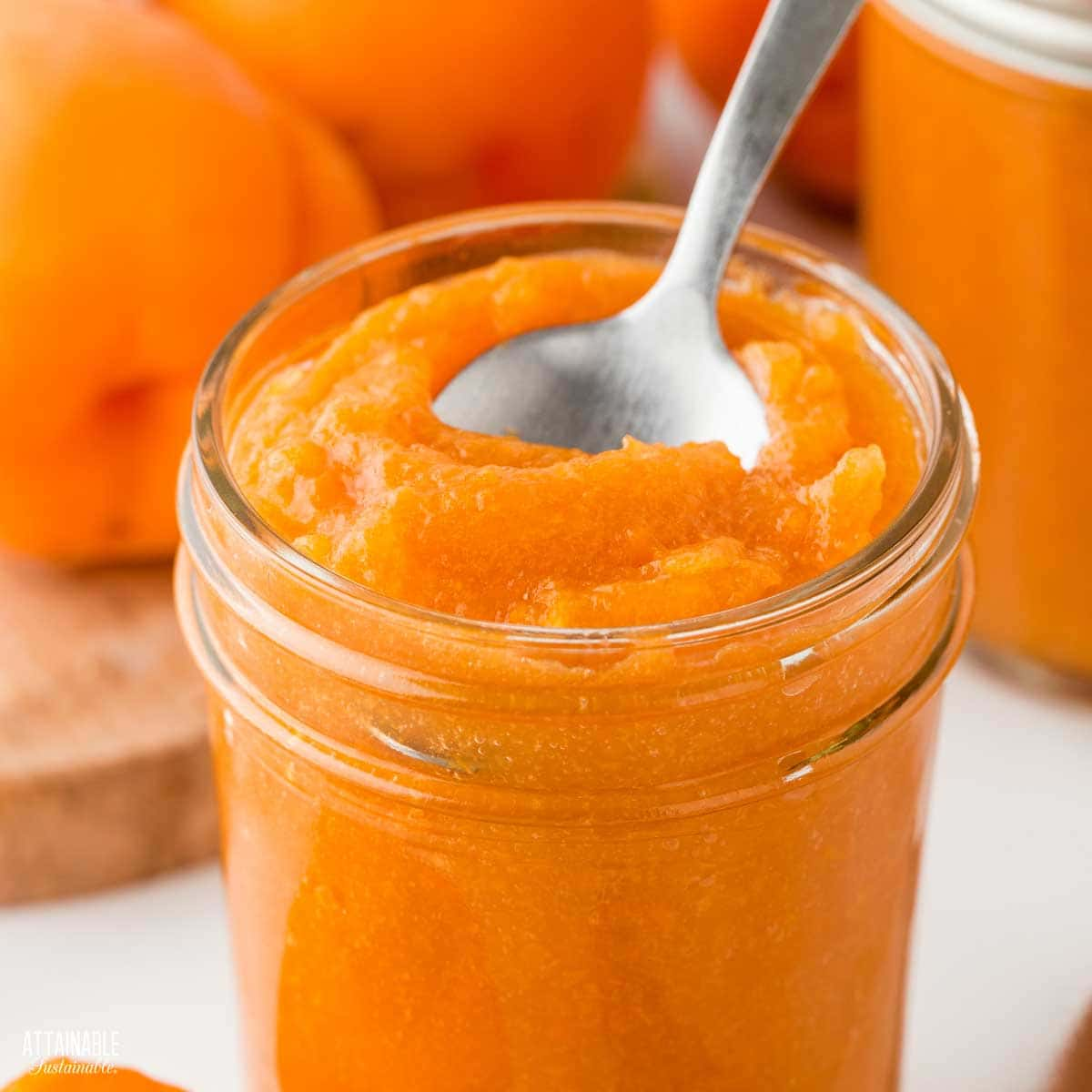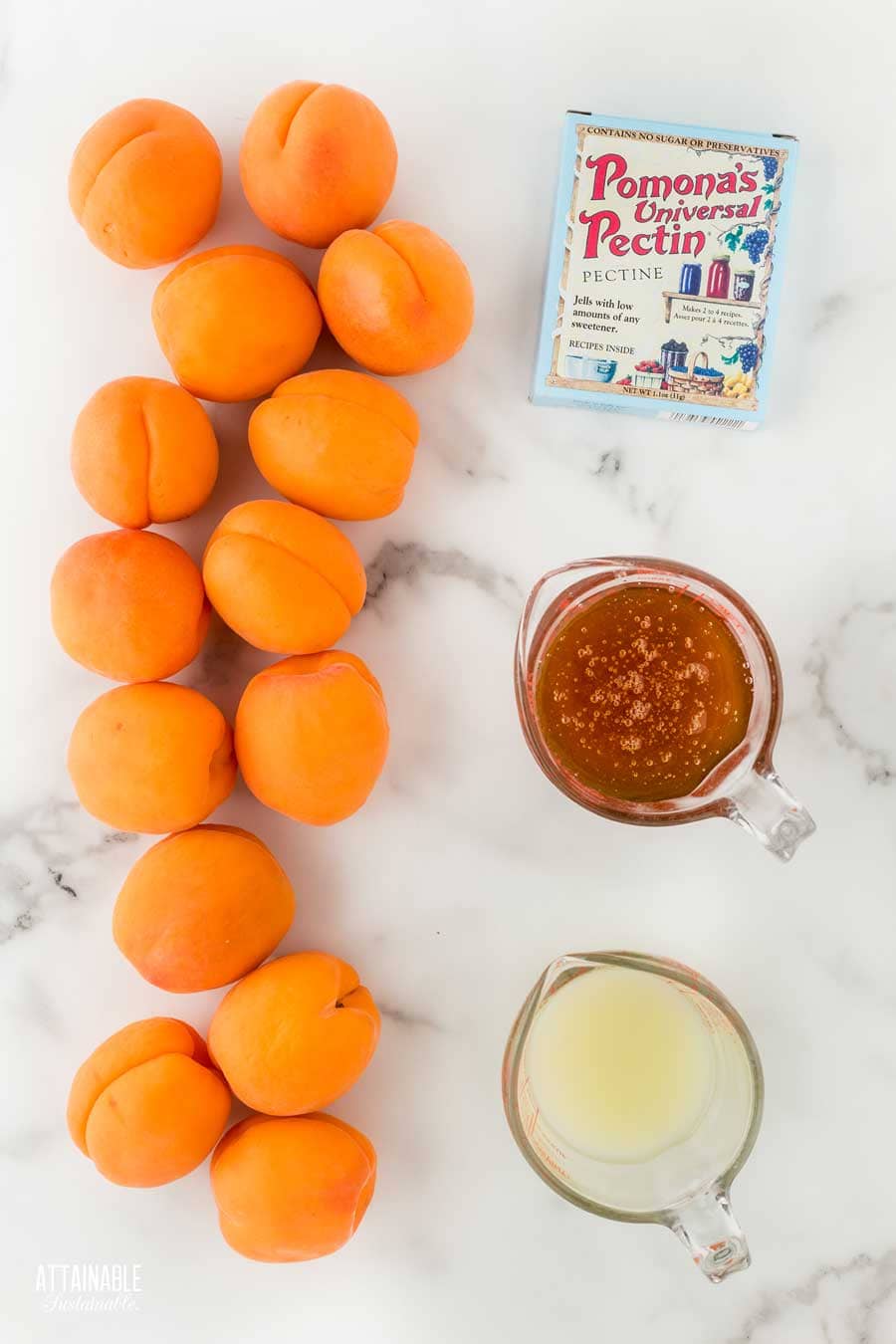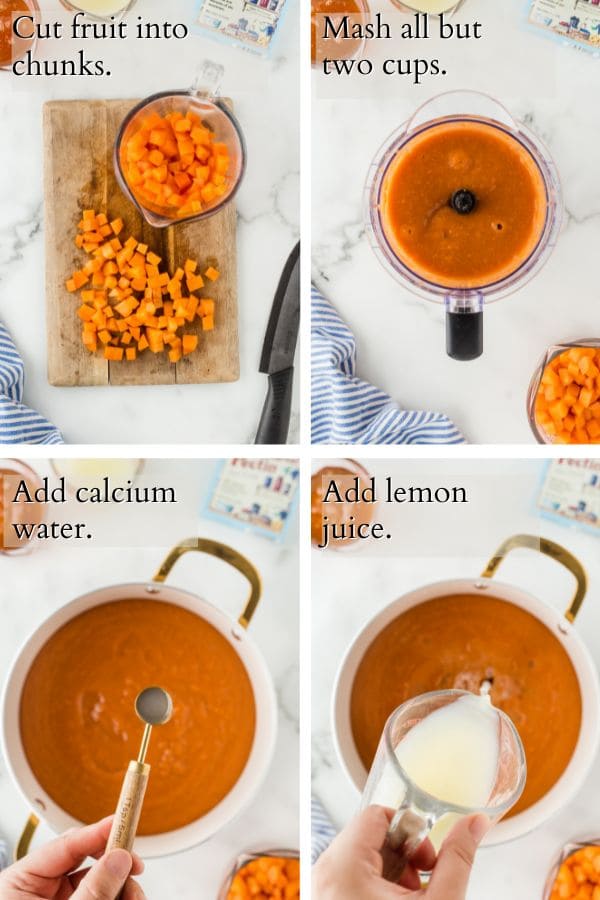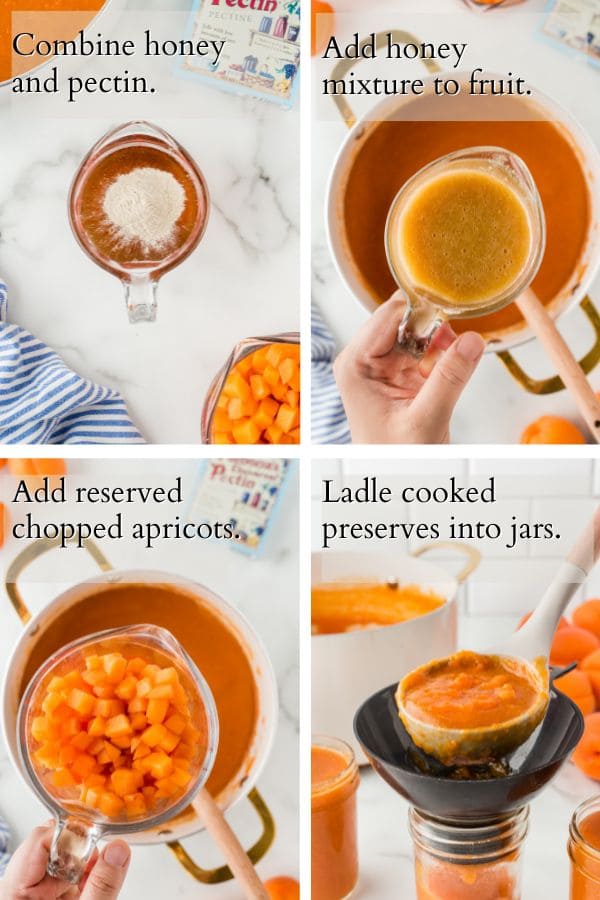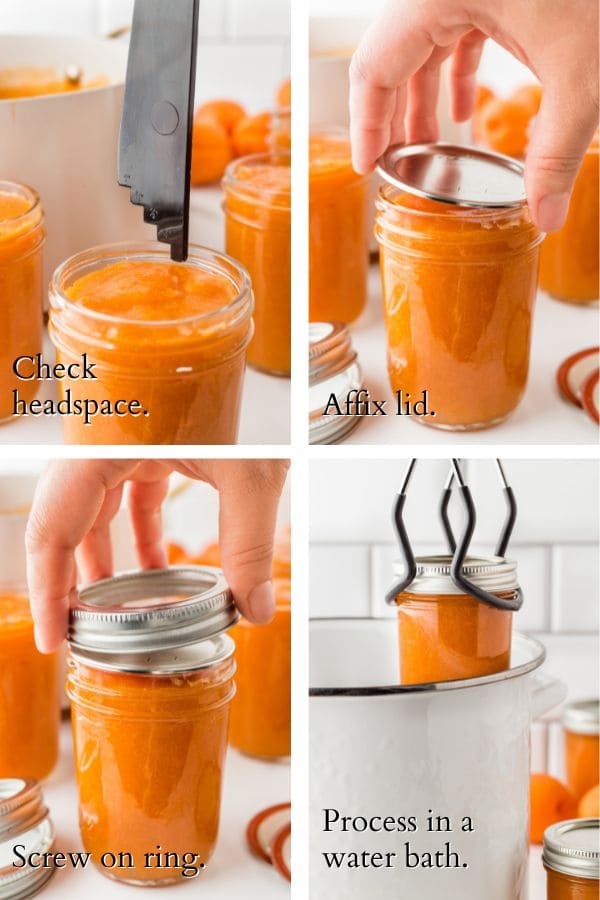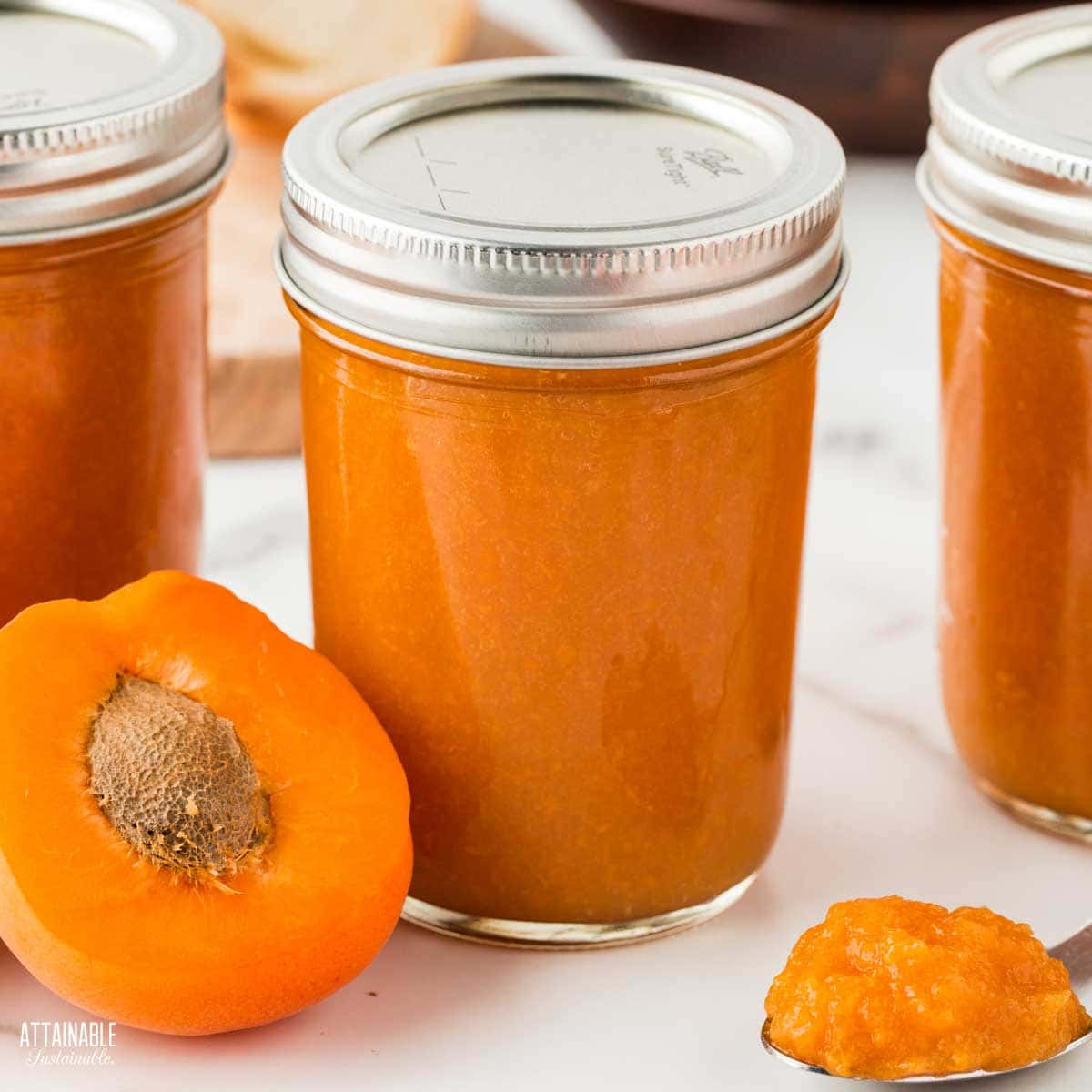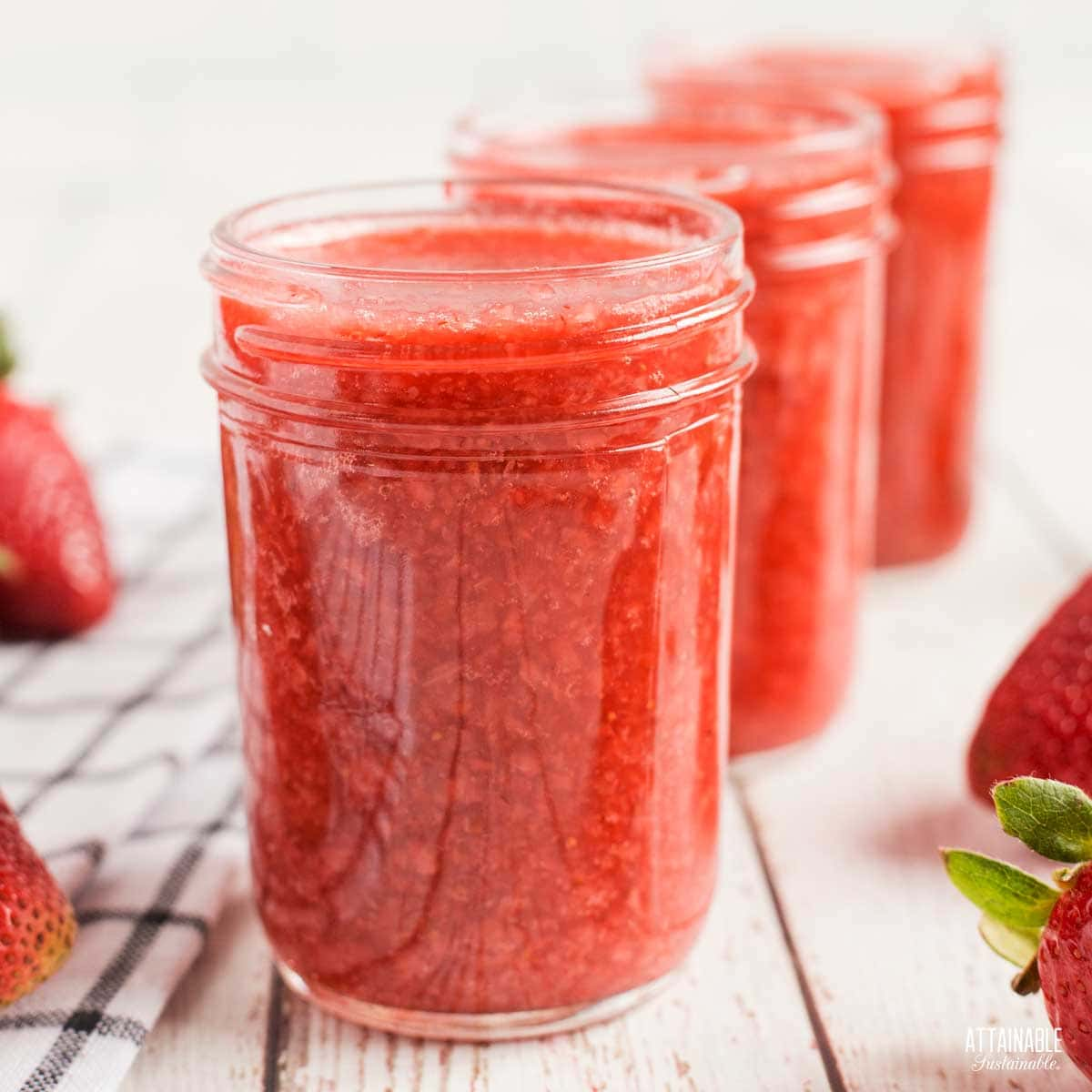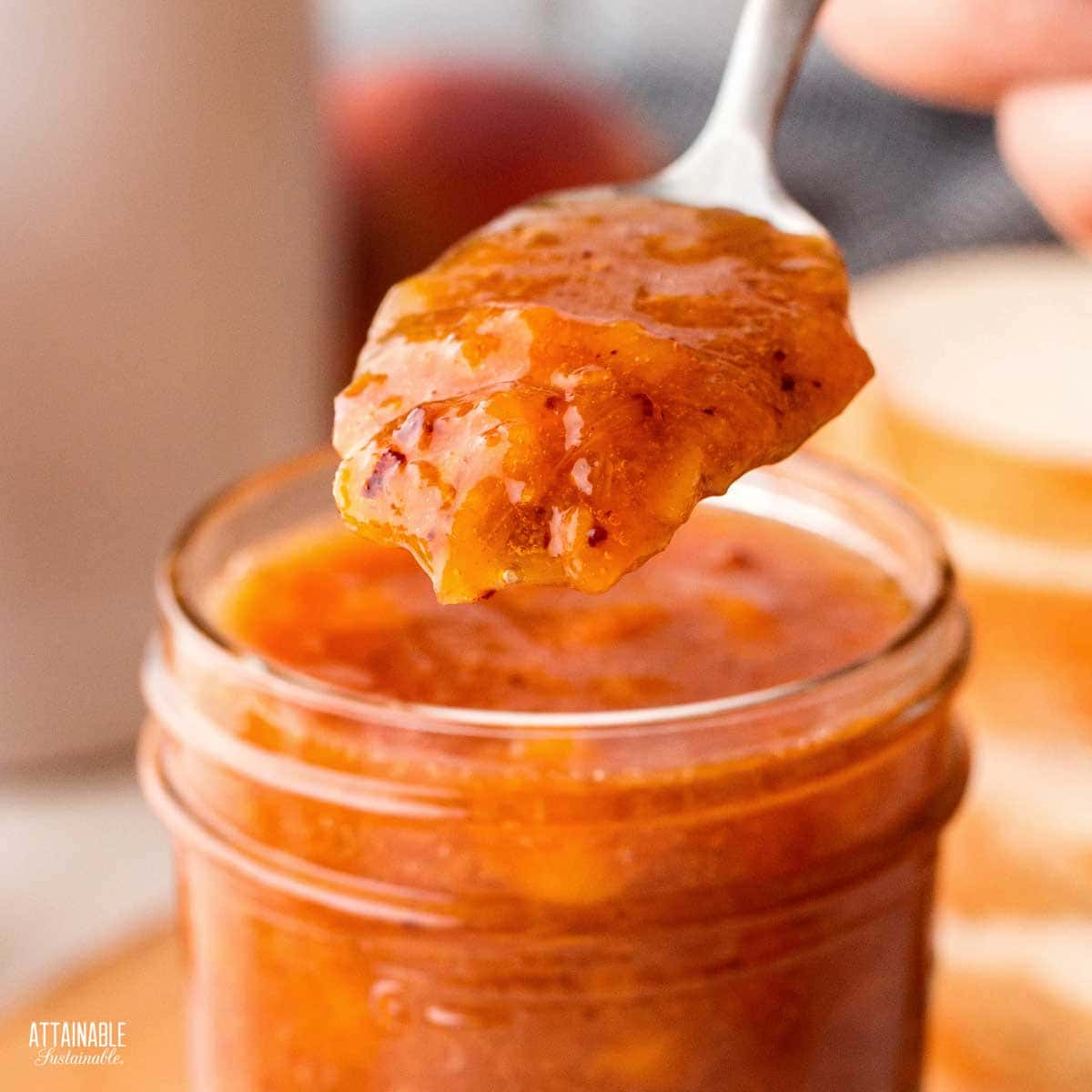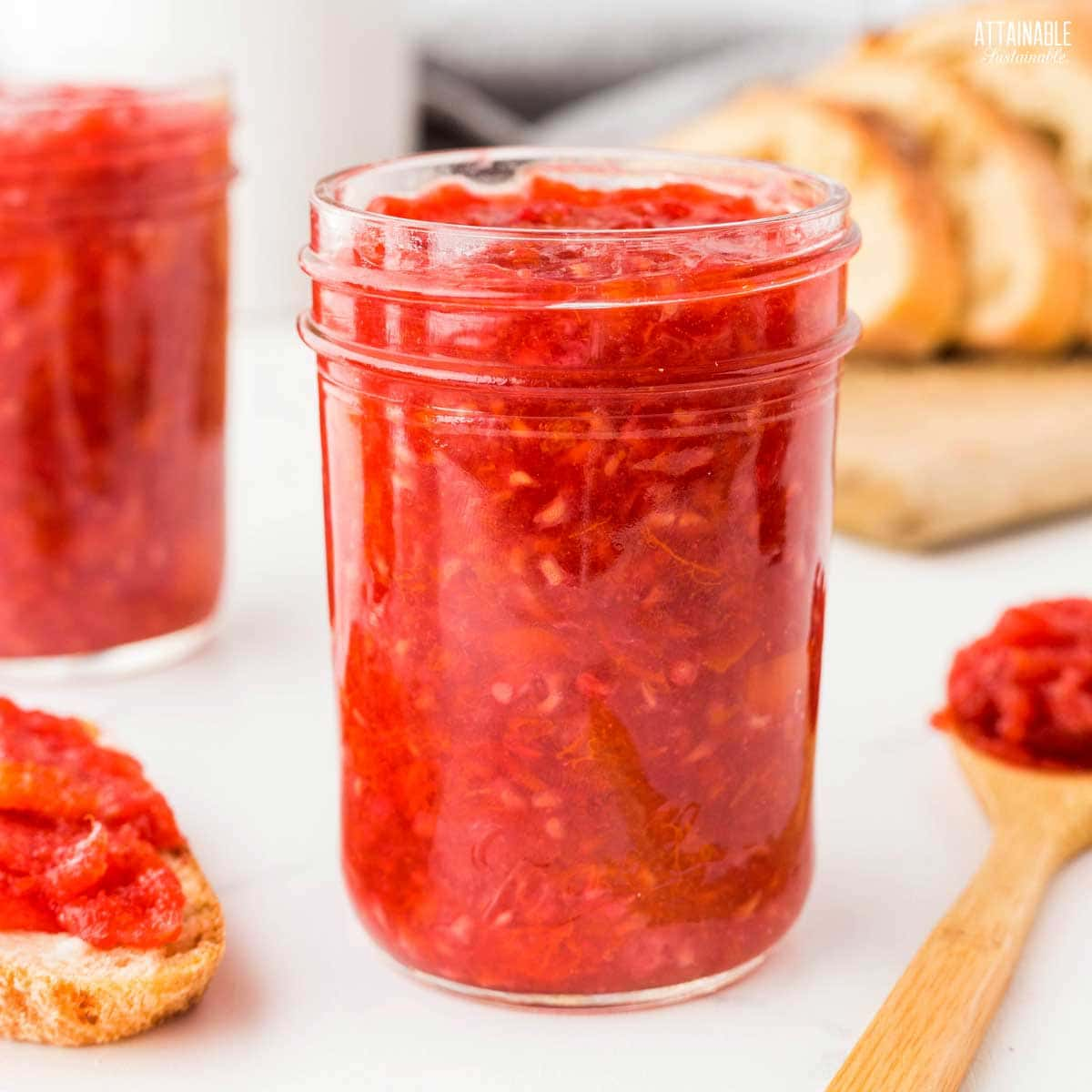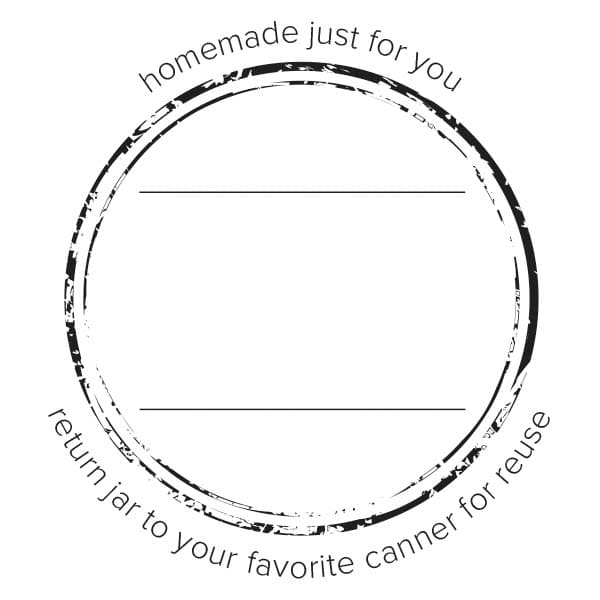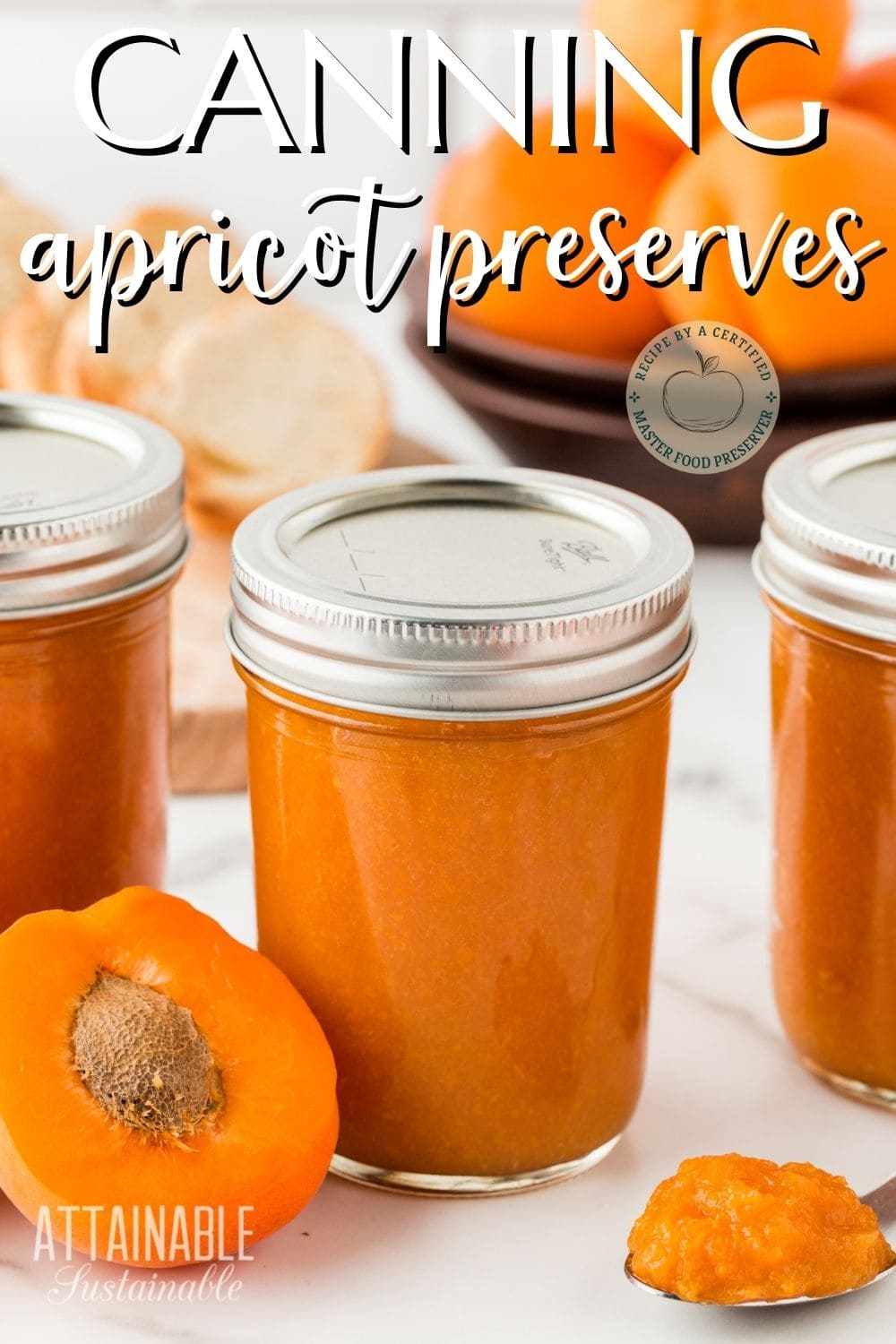These apricot preserves allow the flavor of fresh apricots to shine. With a thicker consistency than jam, these preserves retain bite sized pieces of fruit. Make it a regular addition to your breakfast table!
Store bought fruit spreads are expensive, high in sugar, and often contain high fructose corn syrup, something we try to avoid. Making your own, though? Easy peasy.
The Handcrafted Pantry

Ready to DIY your pantry with more wholesome ingredients? Check out my ebook, The Handcrafted Pantry! Filled with delicious recipes for some of your favorite condiments, snacks, and toppings, it’s the guide you need to start skipping packaged products and embrace homemade.
Apricot Preserves
Apricots are typically in season during the early summer months. If you’re lucky enough to have a tree, this is a wonderful way to preserve some of that flavor for the winter months. Or seek out a grower at the farmers market and pick up some fresh apricots to make these fruit preserves.
Ingredients
Apricots — The key ingredient here, choose fruit that is fully ripe for the best flavor. Avoid overripe fruit.
Sweetener – I used honey for this recipe, but you can opt to use sugar as well. The quantities differ a bit, so be sure to check the notes in the recipe card below.
5 Easy Steps to Transform Your Pantry!
Ready to switch from store bought to homemade? Let me help you make some changes! Grab my FREE five-part guide to getting started.
Lemon juice – Use bottled lemon juice to assure that the resulting pH for this recipe falls within safe canning guidelines.
Pectin – This recipe is made using Pomona’s Universal Pectin. This is the only pectin I use anymore as it allows me to use much less sweetener. The standard pectin brands use an obscene amount of sugar in my opinion, often requiring equal amounts of sugar and fruit! This product uses a low methoxyl method and calls for using two different ingredients, which are included in the box: pectin (the large packet) and calcium powder (the small packet). The dry pectin is mixed with the sweetener before being added to the fruit. The calcium water is added directly to the fruit. This low sugar pectin works a little differently, but makes a delicious, fruit-forward jam.
Making the Preserves
Wash and dry the apricots. Dice enough into half-inch pieces to make two cups; set aside. Mash the remaining fruit using a potato masher. If you’d prefer to remove the fuzzy skins, here’s pears using a blanching method.
Measure six cups of the mashed apricots into a large stockpot along with the calcium water, and lemon juice.
Combine the pectin with the honey, making sure it’s thoroughly combined.
When the apricot mixture reaches a full rolling boil, add the honey to the cooking fruit, stirring for a minute or two to assure that the pectin is well distributed.
Stir in the two cups of reserved diced apricots, return to a boil, boil for one minute, and remove from heat.
This recipe measured at a pH under 3.5, putting it well into the “safe” zone for water bath canning.
Canning Process
You’ll need special canning jars, lids, and rings to make this a shelf-stable product, but the process isn’t difficult.
Transfer hot preserves into canning jars, leaving a quarter-inch headspace. Use a non-metallic knife or bubble tool to remove any air bubbles. Wipe the rims of the jars, removing any residue.
🍅 Safety First!
Canning is an excellent way to preserve food for the pantry, but there are some important safety considerations to keep in mind. The recipes on this site have been made following safe canning procedures by a certified Master Food Preserver.
- Know the difference between water bath canning and pressure canning. Low acid items must be pressure canned for safety.
- Altering ingredients may change the recipe’s pH, posing a safety issue. I highly recommend investing in pH paper to test your products for acidity level when canning. Note: For safe water bath canning, the Hawaii Master Food Preservers suggest a pH of 4.2 or lower in the tropics. In other regions, the recommended pH is 4.6 or lower.
- Use the proper jars and lids. Never reuse lids, with the exception of the Tattler or Harvest Right hard plastic lids that are intended for such a purpose.
- For more on canning equipment, please go here.
- Want to learn more? The National Center for Home Food Preservation is the go-to resource for safe canning information.
Place the lids on and process them in a water bath canner. What this means is you’ll put the filled and sealed jars of jam into boiling water and heat them for ten minutes. This assures that the jars will seal well and kills off any potential bacteria in the jam mixture itself.
Use a jar lifter to remove the hot jars to a towel-covered countertop and allow to cool fully. As they cool, you’ll hear the little “tink” sound of the jars sealing. Store any unsealed jars in the fridge and use those first. (This is unusual, but it does happen once in awhile.)
Remove the ring from each sealed jar of apricot preserves, rinse to remove any sticky residue, and store (without the ring) at room temperature in a dark place such as the pantry. Opened jars should be kept refrigerated; they’ll last in the fridge for several weeks.
100+ MORE Jams, Jellies, and Preserves!
If the idea of stocking your pantry with fruit spreads sounds enticing, this collection of recipes is exactly what you’re looking for.
Strawberry Jam
Savor the flavor of summertime berries with this recipe. It can be made with either sugar or honey. Get the recipe.
Peach Preserves
Are peaches your jam? (See what I did there?) Use this lower sugar recipe to transform fresh peaches into a thick spread. Get the recipe.
Raspberry Jam with Apricots
This homemade raspberry jam has a lower sugar content than some recipes. The addition of fresh apricots gives the finished product a fresh, sunny flavor. Get the recipe.
For more than a hundred different fruit spreads and homemade jam recipes to try, click here.
FAQs
What is the difference between apricot jam and apricot preserves?
Fruit preserves are somewhat chunky, retaining pieces of fruit. Jam is a smoother consistency.
How long will apricot preserves last?
Properly processed, sealed jars of preserves can be safely stored at room temperature for a year or so. Once jars are opened, they’ll last about six weeks in the refrigerator.
★ Did you love this recipe? Be sure to give it a star rating below! ★

Lower Sugar Apricot Preserves
This recipe results in a thick and slightly chunky preserve with the nectar-like flavor of apricots shining through.
Ingredients
- 6-7 pounds of apricots
- 8 teaspoons calcium water (from Pomona's Universal Pectin)
- 1/2 cup lemon juice (bottled)
- 1 cup honey
- 6 teaspoons pectin powder (from Pomona's Universal Pectin)
Instructions
Prepare for Canning
- Prepare the calcium water: Combine ½ teaspoon calcium powder (from the small packet in the box of Pomona’s pectin) with ½ cup water in a small jar. Screw on a lit and shake until well-combined. You'll have more than you need for this recipe. Store the excess in the refrigerator for use in making additional jam or jelly recipes.
- Wash the jars you'll use, making sure each is clean and free of nicks in the rim, which could impede sealing.
- Wash the lids and rings in hot soapy water. (If you're using non-Ball brand lids, prepare as suggested by manufacturer.)
- Place empty jars in a canning pot or large stock pot with enough water to cover by an inch or two, cover pot, and set on high heat. It can take awhile for the water to heat, so get it started before you begin making the recipe.
Make the preserves
- Wash and dry the apricots and dice enough unpeeled apricots into 1/2” pieces to make 2 cups; set aside.
- Mash remaining apricots coarsely with a potato masher or pulse in a food processor until you have 6 cups; transfer to a large pot. Add the prepared calcium water and lemon juice; stir to combine well.
- In a separate bowl, combine the honey with the pectin powder (the large envelope) until thoroughly combined.
- Bring mashed apricots to a full boil. Add honey mixture, stirring vigorously for a couple of minutes to dissolve the pectin. Stir in diced peaches. Return to a full boil, boil for one minute, and remove from heat.
Canning apricot preserves
- Ladle hot preserves into half-pint jars to within a quarter inch of the rim. A canning funnel makes this easy.
- Wipe jar rims to remove any jam that may have spilled. A clean rim is essential to a good seal.
- Set jar lids in place. Screw bands on finger tight.
- Use a jar lifter to gently submerge jars into the hot water bath. Be sure to place a wire rack in the bottom of the pot to prevent the jars of peach jam from sitting directly on the bottom. Water should cover the top of the jars by an inch or two. The water will cool somewhat in reaction to the addition of the jars. Return the water to a low boil and then set the timer.
- Process in a boiling water bath for 10 minutes. Add a minute to the boiling time for every 1,000' above sea level.
- Check seals. Lids should be solid and pulled down tight. (if they flex and pop, the jar didn’t seal; put unsealed jars in the refrigerator and use those first).
- Remove rings and wash outsides of jars. Store in a cool, dry place.
Notes
This recipe is made using Pomona’s Universal Pectin. This is the only pectin I use anymore as it allows me to use much less sweetener. The standard pectin brands use an obscene amount of sugar in my opinion, often requiring equal amounts of sugar and fruit! This product uses a low methoxyl method and calls for using two different ingredients, which are included in the box: pectin (the large packet) and calcium powder (the small packet).
If you'd prefer to use sugar, use 1.5 cups granulated sugar to replace the 1 cup of honey.
This recipe can be made using half-pint jars if you prefer.
This recipe tests below 3.5 pH.
Boiling lids or heating above 180°F as once recommended can damage the sealing compound.
SOURCE: Adapted from guidelines provided by Pomona's Universal Pectin.
